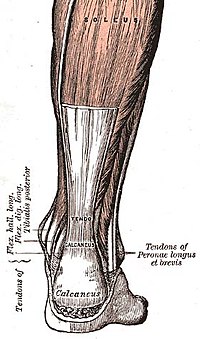| Tendinopathy | |
|---|---|
| Other names | tendinosus[1] |
 | |
| Achilles tendon (a commonly affected tendon) | |
| Specialty | Primary care |
| Symptoms | Pain, swelling[2] |
| Causes | Injury from repetitive activities, overuse[2] |
| Diagnostic method | Based on symptoms, examination, medical imaging[3] |
| Treatment | Rest, NSAIDs, splinting, physiotherapy[2] |
| Prognosis | 80% better within 6 months for overuse tendinopathy[1] |
| Frequency | Common[1][2] |
Tendinopathy is a type of tendon disorder that results in pain, swelling, and impaired function.[2] The pain is typically worse with movement.[2] It most commonly occurs around the shoulder (rotator cuff tendinitis, biceps tendinitis), elbow (tennis elbow, golfer's elbow), wrist, hip, knee (jumper's knee, popliteus tendinopathy), or ankle (Achilles tendinitis).[1][2]
Causes may include an injury or repetitive activities.[2] Less common causes include infection, arthritis, gout, thyroid disease, diabetes and the use of quinolone antibiotic medicines.[4][5] Groups at risk include people who do manual labor, musicians, and athletes.[2] Diagnosis is typically based on symptoms, examination, and occasionally medical imaging.[3] A few weeks following an injury little inflammation remains, with the underlying problem related to weak or disrupted tendon fibrils.[6]
Treatment may include rest, NSAIDs, splinting, and physiotherapy.[2] Less commonly steroid injections or surgery may be done.[2] About 80% of overuse tendinopathy patients recover completely within six months.[1] Tendinopathy is relatively common.[2] Older people are more commonly affected.[2] It results in a large amount of missed work.[1]
- ^ a b c d e f Wilson JJ, Best TM (Sep 2005). "Common overuse tendon problems: A review and recommendations for treatment" (PDF). American Family Physician. 72 (5): 811–8. PMID 16156339. Archived from the original (PDF) on 2007-09-29. Retrieved 2007-04-02.
- ^ a b c d e f g h i j k l m "Tendinitis". National Institute of Arthritis and Musculoskeletal and Skin Diseases. September 2021. Retrieved 11 June 2024.
- ^ a b "Tendinitis". National Institute of Arthritis and Musculoskeletal and Skin Diseases. 12 April 2017. Retrieved 18 November 2018.
- ^ "Fluoroquinolones and risk of Achilles tendon disorders: case-control study". British Medical Journal. 1 June 2002. Retrieved 21 September 2022.
- ^ "Tendinitis". National Institute of Arthritis and Musculoskeletal and Skin Diseases. 12 April 2017. Retrieved 18 November 2018.
- ^ Khan KM, Cook JL, Kannus P, Maffulli N, Bonar SF (2002-03-16). "Time to abandon the "tendinitis" myth: Painful, overuse tendon conditions have a non-inflammatory pathology". BMJ. 324 (7338): 626–7. doi:10.1136/bmj.324.7338.626. PMC 1122566. PMID 11895810.